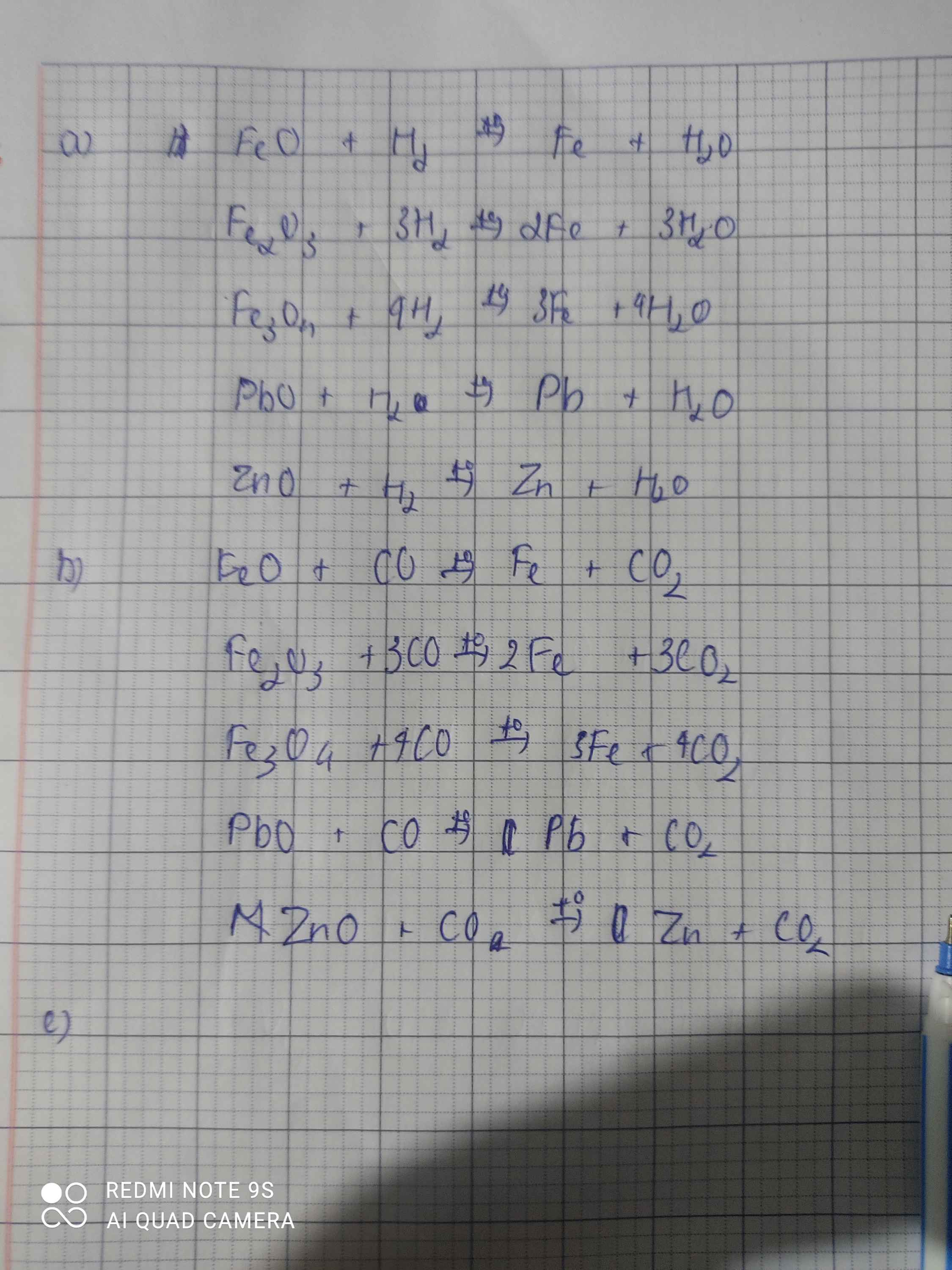cho các oxit :NO2 ,PbO,Al2O3,Fe3O4.oxit có phần trăm khối lượng oxi nhiều hơn cả là

Những câu hỏi liên quan
Cho các oxit: NO2, PbO, Al2O3, Fe3O4. Oxit có phần trăm khối lượng oxi nhiều nhất? Giai thich dum voi a
NO2
=>%O=32\64 .100=50 %
PbO
=>%O=16\223.100=7,17%
Al2O3
=>%O=48\102.100=47%
Fe3O4
=>%O=64\232.100=27,5%
==>NO2 nhiều oxi nhất
cho cac oxit: no2, pbo,al2o3,fe3o4. oxit co phan tram khoi luong oxi nhieu hon ca la :
A .no2. B .pbo. c.al2o3. D. fe3o4
Hợp chất nào có phần trăm khối lượng oxygen nhiều nhất?
A. NO2 B. PbO C.Al2O3 D. Fe3O4
Trong các oxit sau: NO2, N2O5, P2O5, H2O, oxit nào có phần trăm khối lượng oxi lớn nhất?
A. NO2
B. N2O5
C. P2O5
D. H2O
cho các oxit:NO2;PbO;Al2O3;Fe3O4.Oxit có phần trăm khối lg oxi nhiều hơn cả là
% mO (NO2) \(\approx70\%\)
\(\text{% mO}\left(PbO\right)\approx7,2\%\)
\(\text{% mO}\left(Al_2O_3\right)\approx47\%\)
\(\text{% mO}\left(Fe_3O_4\right)\approx28\%\)
Vậy NO2 có % mO nhiều nhất.
Đúng 0
Bình luận (0)
* \(NO_2\)
\(M_{NO_2}=46\left(g/mol\right)\)
\(\%O=\dfrac{16.2}{46}.100\%\approx70\%\)
* \(PbO\)
\(M_{PbO}=223\left(g/mol\right)\)
\(\%O=\dfrac{16}{223}.100\%\approx7\%\)
* \(Al_2O_3\)
\(M_{Al_2O_3}=102\left(g/mol\right)\)
\(\%O=\dfrac{3.16}{102}.100\%\approx47\%\)
* \(Fe_3O_4\)
\(M_{Fe_3O_4}=232\left(g/mol\right)\)
\(\%O=\dfrac{4.16}{232}.100\%\approx28\%\)
Vậy Oxit có \(\%O\) cao nhất là \(NO_2\)
Đúng 0
Bình luận (0)
- \(NO_2\)
\(\%O=\dfrac{16.2}{46}.100\%\approx69,5\%\)
- \(PbO\)
\(\%O=\dfrac{16.1}{223}.100\%\approx7\%\)
- \(Al_2O_3\)
\(\%O=\dfrac{16.3}{102}.100\%\approx47\%\)
- \(Fe_3O_4\)
\(\%O=\dfrac{16.4}{232}.100\%\approx27,5\%\)
Đúng 0
Bình luận (0)
cho các oxit sau Al2O3 ,FeO,Fe2O3,Fe3O4,PbO,ZnO,MgO.viết pthh(nếu có )khi các oxit trên pư vs
a.H2
b,CO
c.C
$a\bigg)$
$FeO+H_2\xrightarrow{t^o}Fe+H_2O$
$Fe_2O_3+3H_2\xrightarrow{t^o}2Fe+3H_2O$
$Fe_3O_4+4H_2\xrightarrow{t^o}3Fe+4H_2O$
$PbO+H_2\xrightarrow{t^o}Pb+H_2O$
$ZnO+H_2\xrightarrow{t^o}Zn+H_2O$
$b\bigg)$
$FeO+CO\xrightarrow{t^o}Fe+CO_2$
$Fe_2O_3+3CO\xrightarrow{t^o}2Fe+3CO_2$
$Fe_3O_4+4CO\xrightarrow{t^o}3Fe+4CO_2$
$PbO+CO\xrightarrow{t^o}Pb+CO_2$
$ZnO+CO\xrightarrow{t^o}Zn+CO_2$
$c\bigg)$
$2FeO+C\xrightarrow{t^o}2Fe+CO_2$
$2Fe_2O_3+3C\xrightarrow{t^o}4Fe+3CO_2$
$Fe_3O_4+2C\xrightarrow{t^o}3Fe+2CO_2$
$2PbO+C\xrightarrow{t^o}2Pb+CO_2$
$2ZnO+C\xrightarrow{t^o}2Zn+CO_2$
Đúng 1
Bình luận (0)
cho các oxit sau Al2O3 ,FeO,Fe2O3,Fe3O4,PbO,ZnO,MgO.viết pthh(nếu có )khi các oxit trên pư vs
a.H2
b,CO
c.C
phân loại và gọi tên các oxit sau: CuO , ZnO , BaO , H2O , N2O5 , Fe2O3 , Ag2O, NO2, PbO , SO3 ,CO2 , N2O3 , K2O , MgO, HgO , CaO, FeO, P2O5, Al2O3, Cu2O,Fe3O4 .
Oxit axit :
- N2O5 : dinito pentaoxit
- NO2 : nito dioxit
- SO3 : lưu huỳnh trioxit
- CO2 : cacbon dioxit
- N2O3 : dinito trioxit
- P2O5 : diphotpho pentaoxit
Oxit bazo :
- CuO : Đồng (II) Oxit
- ZnO : Kẽm oxit
- BaO : Bải oxit
- Fe2O3 : Sắt (III) oxit
- Ag2O : Bạc oxit
- PBO : Chì (II) oxit
- K2O : kali oxit
- MgO : Magie oxit
- HgO : thủy ngân(II) oxit
- CaO : canxi oxit
- FeO : Sắt (II) oxit
- Al2O3 : Nhôm oxit
- Cu2O : Đồng (I) oxit
- Fe3O4 : Oxi sắt từ
Đúng 5
Bình luận (1)
Vì lớp 8 chưa đi sâu oxit lưỡng tính và oxit trung tính nên mình phân 2 loại nha! Oxit axit và oxit bazo.
| Oxit axit | Oxit bazo |
N2O5: đinito pentaoxit NO2: nito đioxit SO3: Lưu huỳnh trioxit CO2: cacbon đioxit N2O3: đinito trioxit P2O5: điphotpho pentaoxit
| CuO: Đồng (II) oxit ZnO: Kẽm oxit BaO: Bari oxit Fe2O3: Sắt(III) oxit Ag2O: Bạc oxit PbO: Chì (II) oxit K2O: Kali oxit HgO: Thủy ngân (II) oxit CaO: Canxi oxit FeO: Sắt(II) oxit Al2O3: Nhôm oxit Cu2O: Đồng (I) oxit Fe3O4: sắt từ oxit MgO: Magie oxit |
H2O vừa là oxit axit, vừa là oxit bazo. (Đihidro oxit)
Đúng 3
Bình luận (3)
CuO: oxit bazơ : đồng(II) oxit
ZnO: oxit bazơ : kẽm oxit
BaO: oxit bazơ: bari oxit
H2O: nước
Đúng 0
Bình luận (0)
Xem thêm câu trả lời
Câu 13. Trong những oxit sau đây: CO2, SO2, NO2, MnO2. Chất có hàm lượng oxi thấp nhất là A. CO2. B. SO2. C. NO2. D. MnO2.Câu 14. Phần trăm khối lượng của Fe trong FeO làA. 48%. B. 68%. C. 58%. D. 78%.Câu 15. Phần trăm khối lượng của O trong CO2 làA. 46%. B. 73%. C. 68%. D. 54%.Câu 16. Thành phần phần trăm khối lượng nguyên tố S trong hợp chất FeS làA. 63,63%. B. 36,36%. C. 31,31%. D. 18,18%.
Đọc tiếp
Câu 13. Trong những oxit sau đây: CO2, SO2, NO2, MnO2. Chất có hàm lượng oxi thấp nhất là
A. CO2. B. SO2. C. NO2. D. MnO2.
Câu 14. Phần trăm khối lượng của Fe trong FeO là
A. 48%. B. 68%. C. 58%. D. 78%.
Câu 15. Phần trăm khối lượng của O trong CO2 là
A. 46%. B. 73%. C. 68%. D. 54%.
Câu 16. Thành phần phần trăm khối lượng nguyên tố S trong hợp chất FeS là
A. 63,63%. B. 36,36%. C. 31,31%. D. 18,18%.



































